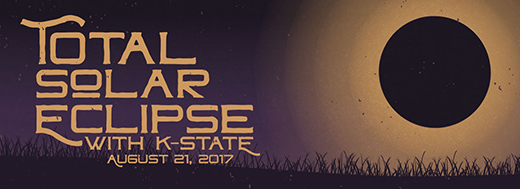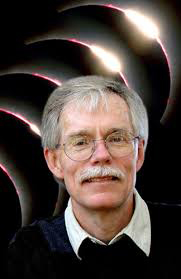The Great American Eclipse of 2017: April 11 lecture, astrophotography class kick off series of eclipse events
Thursday, April 6, 2017
Chris Sorensen, Kansas State University distinguished professor of physics, discusses the importance of the Aug. 21 total solar eclipse and describes the path of totality. | Download video package.
MANHATTAN — Kansas State University is celebrating the sight of a lifetime: the Great American Eclipse of 2017.
On Aug. 21, the moon will completely cover the sun and portions of the U.S. — including northeast Kansas — will experience a total eclipse of the sun. It is the first total eclipse of the sun visible in the U.S. since 1979 and is the first total solar eclipse visible in Kansas in 99 years.
Kansas State University will host a series of speakers, events and classes to prepare for the eclipse. The events begin with the 2017 Neff Public Lecture in Physics at 4:30 p.m. on Tuesday, April 11, in 101 Cardwell Hall. The lecture, sponsored by the physics department, will feature Fred Espenak, scientist emeritus of NASA's Goddard Space Flight Center, and is open to the public.
Espenak is known as "Mr. Eclipse" because of his work predicting and observing solar eclipses.
Before the lecture, Espenak will host an astrophotography workshop at 3 p.m. in Room 101 in Cardwell Hall. He will help amateur and professional photographers learn how to use cameras, including cellphone cameras, to shoot wide-angle photos of totality; how to capture partial phases, the diamond-ring effect and Baily's beads; and how to shoot bracketed exposures to capture the inner, middle and outer corona. Espenak will offer tips on the best telephoto lenses, telescopes and solar filters. Participants should bring their cameras, lenses and questions.
During the lecture, Espenak will discuss the solar eclipse phenomenon, where the moon covers the disk of the sun. For the total eclipse of 2017, the moon's shadow will move across the U.S. from Oregon to northeast Kansas to South Carolina. The movement will leave a 68-mile-wide path of totality where the moon will completely cover the sun for two minutes and the sun's corona will be visible.
Espenak has written more than a dozen books on eclipses, including his most recent "Eclipse Bulletin: Total Solar Eclipse of 2017 August 21." Throughout the past 45 years, he has witnessed 26 total eclipses of the sun. Espenak lives in Portal, Arizona, where he operates Bifrost Astronomical Observatory.
A lecture live stream will be available at www.phys.ksu.edu/alumni/neff/2017/index.html.
Other eclipse events
Several Kansas State University organizations — including the physics department, K-State Global Campus, the K-State Alumni Association, the Office of Student Life and the Division of Communications and Marketing — are partnering with the Flint Hills Discovery Center for a series of outreach events to celebrate the 2017 solar eclipse.
"In Kansas, this eclipse is even more special, because not only is it an alignment of the sun, the moon and the Earth, but it is an alignment of the sun, the moon and Kansas to make it a very special event for us," said Chris Sorensen, Cortelyou-Rust university distinguished professor of physics and one of the organizers of the events.
The events include lectures, classes and community activities. More details will be provided and additional events may be added in the coming months. All of the following are open to the public:
• Astronomy in Color Lunch and Learn,noon Monday, April 24, McVay Family Town Hall in the Leadership Studies Building. This event is sponsored by the K-State Alumni Association and will explore the influence of astronomy in Black, Asian and Pacific Islander cultures.
• Astronomy viewing nights, 9 to 11 p.m. Friday, June 2, and Friday, July 14, Flint Hills Discovery Center. Sorensen will help visitors view the moon, the planets and the stars through telescopes at these free events.
• Community Day, noon to 6 p.m. Sunday, Aug. 6, Flint Hills Discovery Center. This free day will feature astronomy-themed and community activities.
• Go See It! Total Solar Eclipse by Professor Chris Sorensen, 6:30 p.m. to 7:30 p.m. Thursday, Aug. 17, Flint Hills Discovery Center. Sorensen will give a lecture to prepare for the Aug. 21 total solar eclipse.
• Eclipse watch parties and bus trips.Aug. 21. More information to come.


